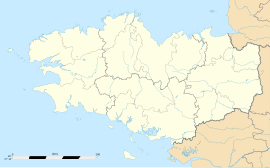geo.wikisort.org - Island
Groix (French pronunciation: [ɡʁwa]; Breton: Enez Groe) is an island and a commune in the Morbihan department of the region of Brittany in north-western France.
Groix
Groe | |
|---|---|
Commune | |
 Port Tudy, main harbor of Groix island | |
 Coat of arms | |
Location of Groix  | |
 Groix  Groix | |
| Coordinates: 47°38′22″N 3°27′13″W | |
| Country | France |
| Region | Brittany |
| Department | Morbihan |
| Arrondissement | Lorient |
| Canton | Lorient-2 |
| Intercommunality | Lorient Agglomération |
| Government | |
| • Mayor (2020–2026) | Dominique Yvon[1] |
| Area 1 | 14.82 km2 (5.72 sq mi) |
| Population | 2,234 |
| • Density | 150/km2 (390/sq mi) |
| Time zone | UTC+01:00 (CET) |
| • Summer (DST) | UTC+02:00 (CEST) |
| INSEE/Postal code | 56069 /56590 |
| Elevation | 0–48 m (0–157 ft) |
| 1 French Land Register data, which excludes lakes, ponds, glaciers > 1 km2 (0.386 sq mi or 247 acres) and river estuaries. | |
Groix lies a few kilometres off the coast of Lorient. Several ferries a day run from Lorient to Groix.
There are a few small towns on the island. High cliffs are on its north coast and sandy beaches in secluded coves on the south coast. Groix is also home to a wide variety of sea birds. Groix is also famous for hosting the only convex beach in Europe, which also moves following sea currents. During the last 15 years, the beach moved half a kilometer westbound.
The geology of Groix is distinct from that of the nearby continent, and the east and south coasts have been designated a mineral nature reserve since 1982.[citation needed] More than 60 minerals can be found on the island, particularly blue glaucophane (observable on the surface), epidote or garnet.[citation needed] The island mainly consists of schist.[citation needed]
A major naval battle between Britain and France took place off Groix in 1795.
Climate
| Climate data for Groix (1981–2010 averages) | |||||||||||||
|---|---|---|---|---|---|---|---|---|---|---|---|---|---|
| Month | Jan | Feb | Mar | Apr | May | Jun | Jul | Aug | Sep | Oct | Nov | Dec | Year |
| Record high °C (°F) | 15.4 (59.7) |
16.6 (61.9) |
22.8 (73.0) |
25.8 (78.4) |
29.7 (85.5) |
35.6 (96.1) |
35.3 (95.5) |
35.2 (95.4) |
31.0 (87.8) |
26.5 (79.7) |
19.5 (67.1) |
16.0 (60.8) |
35.6 (96.1) |
| Average high °C (°F) | 9.5 (49.1) |
9.5 (49.1) |
11.5 (52.7) |
13.6 (56.5) |
16.6 (61.9) |
19.2 (66.6) |
21.0 (69.8) |
21.3 (70.3) |
19.8 (67.6) |
16.3 (61.3) |
12.7 (54.9) |
10.2 (50.4) |
15.1 (59.2) |
| Average low °C (°F) | 5.7 (42.3) |
5.3 (41.5) |
6.8 (44.2) |
7.9 (46.2) |
10.8 (51.4) |
13.3 (55.9) |
15.1 (59.2) |
15.3 (59.5) |
13.8 (56.8) |
11.7 (53.1) |
8.8 (47.8) |
6.4 (43.5) |
10.1 (50.2) |
| Record low °C (°F) | −9.4 (15.1) |
−8.0 (17.6) |
−6.2 (20.8) |
−1.0 (30.2) |
0.4 (32.7) |
5.8 (42.4) |
7.8 (46.0) |
8.4 (47.1) |
7.6 (45.7) |
1.8 (35.2) |
−2.4 (27.7) |
−6.0 (21.2) |
−9.4 (15.1) |
| Average precipitation mm (inches) | 95.7 (3.77) |
70.6 (2.78) |
65.0 (2.56) |
61.3 (2.41) |
59.2 (2.33) |
42.2 (1.66) |
42.7 (1.68) |
39.1 (1.54) |
56.4 (2.22) |
92.3 (3.63) |
91.3 (3.59) |
98.9 (3.89) |
814.7 (32.07) |
| Average relative humidity (%) | 87 | 86 | 85 | 82 | 84 | 83 | 83 | 83 | 83 | 86 | 86 | 88 | 84.7 |
| Source 1: Météo France[3] | |||||||||||||
| Source 2: Infoclimat.fr (humidity, 1961–1990)[4] | |||||||||||||
Demographics
Inhabitants of Groix are called Groisillons.

See also
References
- "Maires du Morbihan" (PDF). Préfecture du Morbihan. 7 July 2020.
- "Populations légales 2019". The National Institute of Statistics and Economic Studies. 29 December 2021.
- "Données climatiques de la station de Ile de Groix" (in French). Meteo France. Retrieved December 30, 2015.
- "Normes et records 1961-1990: Ile de Groix - Beg Melen (56) - altitude 42m" (in French). Infoclimat. Retrieved December 30, 2015.
Bibliography
External links
- Official site (in French)
- Ile de Groix
- Groix info
- Ile-de-groix.info
- Geomorphology of the area
- Base Mérimée: Search for heritage in the commune, Ministère français de la Culture. (in French)
На других языках
[de] Île de Groix
Die Île de Groix [.mw-parser-output .IPA a{text-decoration:none}il də ɡʁwa] (bretonisch: Enez Groe) ist eine 2,5 Kilometer breite und 6 Kilometer lange französische Atlantikinsel im Département Morbihan in der Bretagne. Sie liegt 8 Kilometer südlich von Lorient. Ihre Leuchtfeuer dienen Schiffen als Navigationshilfe.- [en] Groix
[es] Groix
Groix, Enez Groe en bretón, es una isla, una localidad y una comuna francesa situada en la región de Bretaña, en el departamento de Morbihan y el cantón de Groix.[fr] Groix
Groix (/gʁwa/) est une île et une commune française du département du Morbihan en région Bretagne. Surnommée l'île aux grenats, elle se trouve dans le golfe de Gascogne, au large de la côte sud de la Bretagne, au nord-ouest de Belle-Île-en-Mer et en face de Ploemeur. Elle constitue une commune (commune de l'Île de Groix), et, jusqu'à 2015, constituait aussi le canton de Groix (qui fait maintenant partie du canton de Lorient-2). Elle est accessible par bateau au départ de Lorient, de Port-Louis et du port de Doëlan. Historiquement, elle fait partie du pays vannetais et du Kemenet-Héboé.[ru] Груа
Груа (фр. Île de Groix, брет. Groe) — небольшой остров в заливе Морбиан. Административно является коммуной, относящейся к бретанскому департаменту Морбиан.Другой контент может иметь иную лицензию. Перед использованием материалов сайта WikiSort.org внимательно изучите правила лицензирования конкретных элементов наполнения сайта.
WikiSort.org - проект по пересортировке и дополнению контента Википедии